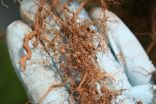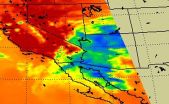(Press-News.org) (PHILADELPHIA) – Transfer RNAs (tRNAs) are ancient workhorse molecules and part of the cellular process that creates the proteins, critical building blocks of life that keep a cell running smoothly. A new discovery suggests that the number of human genomic loci that might be coding for tRNAs is nearly double what is currently known. Most of the newly identified loci resemble the sequences of mitochondrial tRNAs suggesting unexpected new links between the human nuclear and mitochondrial genomes, links that are not currently understood.
Transfer RNAs (tRNAs) represent an integral component of the translation of a messenger RNA (mRNA) into an amino acid sequence. TRNAs are non-coding RNA molecules and can be found in all three kingdoms of life i.e., in archaea, bacteria and eukaryotes.
At the DNA level, a triplet of consecutive nucleotides known as the "codon" is used to encode an amino acid. Frequently, a given amino acid can be encoded by more than one codon: in fact, there are 61 distinct codons encoding the 20 standard human amino acids. During translation, each of the codons contained in the coding region of the mRNA at hand is recognized by its matching tRNA and the corresponding amino acid added to the nascent amino acid sequence. It has been known for many years that each of these 61 tRNAs has multiple copies spread throughout the genome that is found in the human nucleus. The presence of multiple genomic loci from which the same molecule can be made is a fairly standard trick of genomic organization: processing these loci in parallel can ensure that adequate amounts of each tRNA can be generated quickly enough to meet the high demand that the amino acid translation process imposes on the cell. In addition to the 61 tRNAs that are found in the human nuclear genome, 22 more tRNAs are encoded in the genome of the cellular organelle known as the mitochondrion: the mitochondrion, originally a bacterium itself, uses these 22 tRNAs to make proteins out of the just-over-a-dozen mRNAs that are encoded in its genome.
Recent research efforts have shown that tRNAs can have other roles, which go beyond their involvement in protein synthesis. For example, tRNAs can affect the physiology of a cell, they can modulate the abundance of important molecules, etc. These and other unexpected findings have revived interest in looking at tRNAs, this time under a different prism. But, how many tRNAs are actually encoded by the human genome and could be potentially involved in amino acid translation and other processes?
A team led by Isidore Rigoutsos, Director of the Computational Medicine Center at Thomas Jefferson University (TJU), set out to tackle this question and they have reported their findings in a study that was just published in the journal Frontiers in Genetics. "What we found, frankly, surprised us," said Rigoutsos.
The team searched the 3 billion base pairs of the human genome for DNA sequences that resembled the 530 known nuclear and mitochondrial tRNAs. Even though they used very stringent criteria in their searches, they found 454 "lookalike" loci, i.e., sequences that look like tRNA, but haven't yet been experimentally confirmed as such. The researchers found nearly as many as the known ones with which they started: 81% of these tRNA-lookalikes had not been reported previously. Rather unexpectedly, the team found that most of these new loci resembled some of the 22 mitochondrial tRNAs.
Interestingly, the discovered tRNA lookalikes are not spread uniformly across the 24 chromosomes. Instead, they have penetrated preferentially some chromosomes and have avoided others. For example, chromosomes 1, 2, 7, 8 and 9 claim the lion's share of the discovered tRNA-lookalikes. On the other hand, chromosome 18 contains no lookalikes. Also, some of the codons are particularly over-represented among the lookalikes whereas other codons are absent.
The surprises did not stop there. The team also discovered that in the chromosomes where the tRNA-lookalikes are found their locations are not accidental either. Instead, the lookalikes are positioned in close proximity to known nuclear tRNAs. This of course begs the question whether the tRNA-lookalikes are transcribed, just like the known tRNAs. By examining public repositories, the team found evidence of transcription for more than 20% of the discovered tRNA-lookalikes: the transcriptional profiles appear to depend on cell type, which suggests that more of the look-alikes will be found to be transcribed as data from more cell types become available. On several occasions, the public data revealed evidence for molecules whose endpoints matched exactly the endpoints of the tRNA-lookalikes discovered by the team. "This is certainly exciting, but it is currently unclear whether these molecules participate in translation as tRNAs, or have entirely different roles," said Rigoutsos.
INFORMATION:
The authors report no conflicts of interest.
For more information, contact Edyta Zielinska, 215-955-5291, edyta.zielinska@jefferson.edu.
About Jefferson
Thomas Jefferson University (TJU), the largest freestanding academic medical center in Philadelphia, is nationally renowned for medical and health sciences education and innovative research. Thomas Jefferson University includes the Sidney Kimmel Medical College (SKMC), one of the largest private medical schools in the country and ranked among the nation's best medical schools by U.S. News & World Report, the Graduate School of Biomedical Sciences and the Jefferson Schools of Nursing, Pharmacy, Health Professions, and Population Health. Jefferson University Physicians is TJU's multi-specialty physician practice consisting of the full-time faculty of SKMC. Thomas Jefferson University partners with its clinical affiliate, Thomas Jefferson University Hospitals.
Article Reference
A.G. Telonis et al., "Nuclear and mitochondrial tRNA-lookalikes in the human genome," Frontiers in Genetics, doi: 10.3389/fgene.2014.00344, 2014.
CORVALLIS, Ore. – A study of the removal of two dams in Oregon suggests that rivers can return surprisingly fast to a condition close to their natural state, both physically and biologically, and that the biological recovery might outpace the physical recovery.
The analysis, published by researchers from Oregon State University in the journal PLOS One, examined portions of two rivers – the Calapooia River and Rogue River. It illustrated how rapidly rivers can recover, both from the long-term impact of the dam and from the short-term impact of releasing stored ...
Alexandria, Va. — When Francisco Pizarro landed in Peru in 1532, his band of Spanish conquistadors set off a chain of far-reaching consequences for the people and economics of western South America. The Chira Beach-Ridge Plain in northwestern Peru is rippled by a set of nine ridges — several meters tall by up to 300 meters wide and 40 kilometers long, and large enough to be visible from space — running parallel to the shoreline. The pattern, observed along at least five other Peruvian beaches, was thought to have formed naturally over the past 5,000 years. ...
Reports of insomnia are common among the elderly, but a new study finds that sleep problems may stem from the quality of rest and other health concerns more than the overall amount of sleep that patients get.
An estimated 30 percent of adults report having some symptoms of insomnia, which includes difficulty falling asleep, staying asleep or waking up too early and then not feeling well rested during the daytime. Prior studies suggest that nearly half of older adults report at least one insomnia symptom and that lack of restorative sleep might be linked to heart disease, ...
As the effects of a changing climate become acute, organizations charged with overseeing refuge areas must take action to adapt. The US Fish and Wildlife Service (USFWS) maintains the National Wildlife Refuge System, which constitutes world's largest system of protected lands and waters. According to a November BioScience article by Robert Fischman and Vicky Meretsky of Indiana University and their coauthors, the service may not always be adequately planning for an altered future, but best practices from several plans point the way for improvement. For instance, existing ...
Using a high-throughput screening assay, EPFL scientists have discovered two small molecules that could overcome the multidrug resistance of the bacterium that causes tuberculosis.
Tuberculosis is an infectious disease caused by a bacterium called Mycobacterium tuberculosis (Mtb), which commonly infects the lungs. In 2012, the World Health Organization estimated that tuberculosis affected 8.6 million people worldwide, causing death in 1.4 million. However, the fight against the disease is hampered by the fact that treatment requires a long time and that Mtb often develops ...
(NEW YORK, NY, Oct. 8, 2014) – Nursing home infection rates are on the rise, a study from Columbia University School of Nursing found, suggesting that more must be done to protect residents of these facilities from preventable complications. The study, which examined infections in U.S. nursing homes over a five-year period, found increased infection rates for pneumonia, urinary tract infections (UTIs), viral hepatitis, septicemia, wound infections, and multiple drug-resistant organisms (MDROs).
"Infections are a leading cause of deaths and complications for nursing ...
URBANA, Ill. – Because of its aggressive behavior and its harmful effects, the invasive prairie plant Lespedeza cuneata has been added to several noxious weed lists.
Research at the University of Illinois on how soil bacteria interact with the plants' roots to form nodules that fix nitrogen demonstrated that the invasive variety had superior performance when pitted against the native plant variety Lespedeza virginica.
"We expected Lespedeza cuneata to be a strong competitor when up against its native cousin that's planted primarily for prairie restoration," ...
COLUMBIA, Mo. — Researchers at the University of Missouri School of Medicine have identified epigenetic protein changes caused by binge drinking, a discovery that could lead to treatments for alcohol-related liver diseases.
"We know that chronic alcohol use is damaging to the liver, but binge drinking amplifies that damage," said Shivendra Shukla, Ph.D., Margaret Proctor Mulligan Professor at the MU School of Medicine and lead author of the study.
Excessive alcohol use is one of the most common causes of chronic liver failure. Long-term liver damage from alcohol ...
This news release is available in German. It does seem slightly odd at first: you hold the phone in one hand, and move the other in the air above its built-in camera making gestures that resemble sign language. Sometimes you move your index finger to the left, sometimes to the right. You can spread out your fingers, or imitate a pair of pliers or the firing of a pistol. These gestures are not, however, intended for communicating with deaf people; they are for controlling your smartphone.
By mimicking the firing of a pistol, for example, a user can switch to another ...
The remnants of Hurricane Simon were fanning out over the desert Southwestern U.S. on Oct. 8 and NASA's Aqua satellite captured infrared data on the thunderstorms expected to bring flash flooding.
NOAA's National Weather Service (NWS) indicated on Oct. 8, that Simon's remnants would be bringing heavy rain and the possibility of flash flooding to the desert Southwest. NWS noted "Moisture associated with the remnants of Tropical Storm Simon will bring showers and isolated thunderstorms to parts of the Desert Southwest on Wednesday. Rainfall totals of up to an inch or more ...




